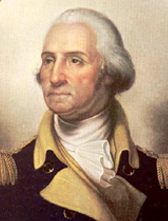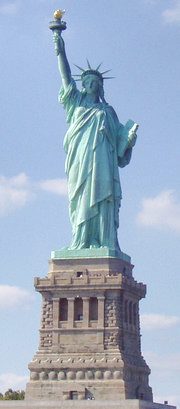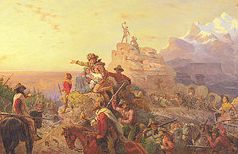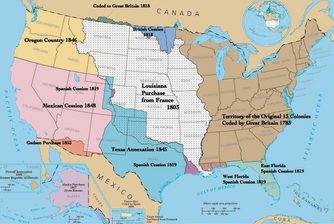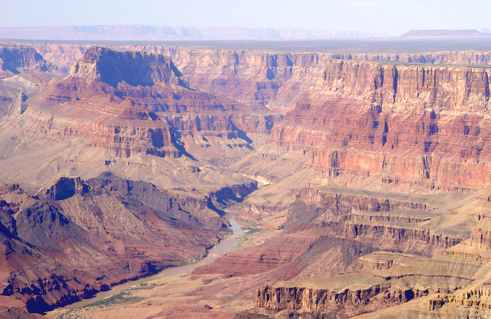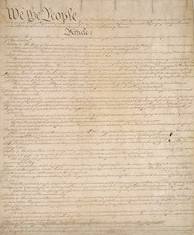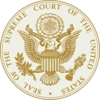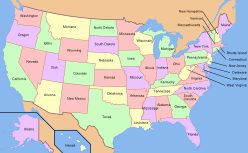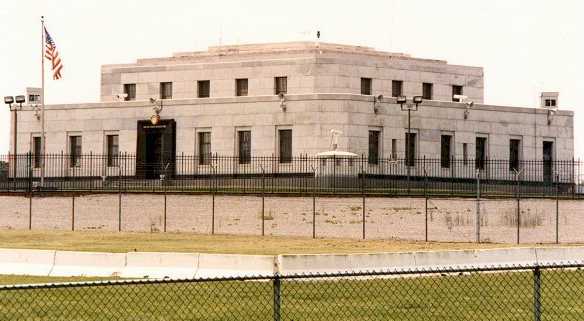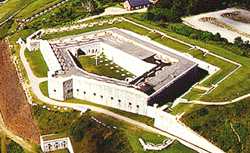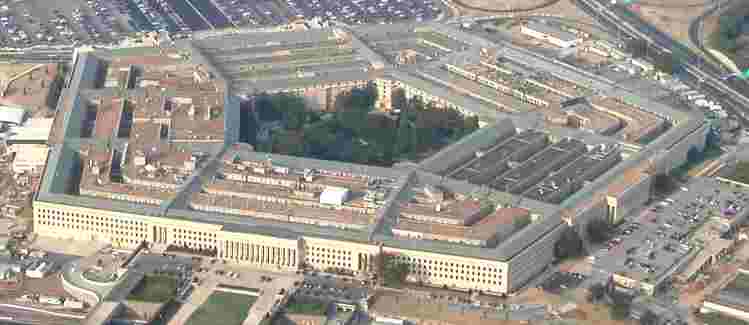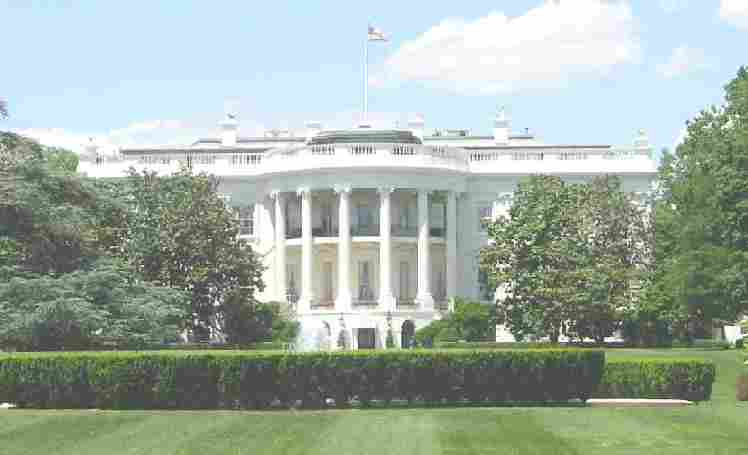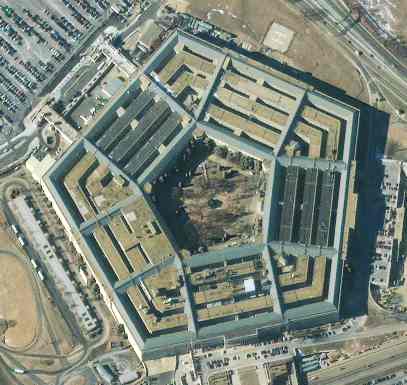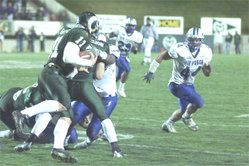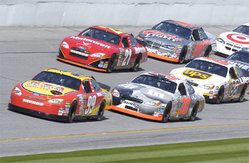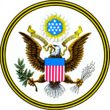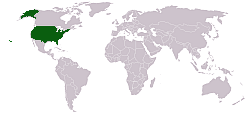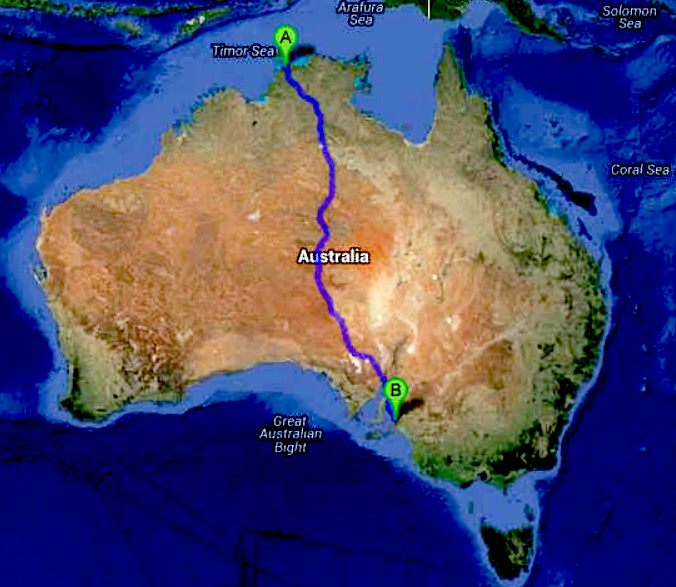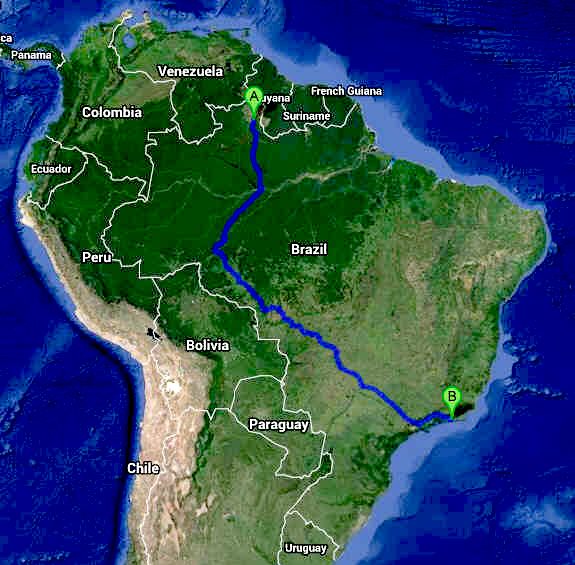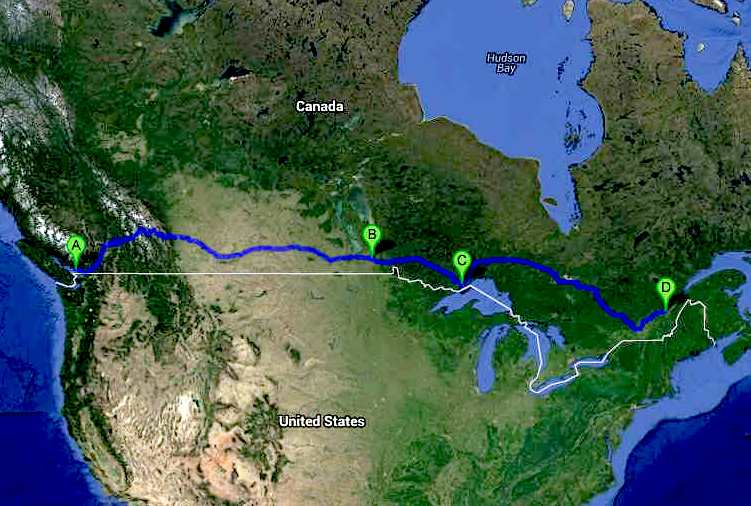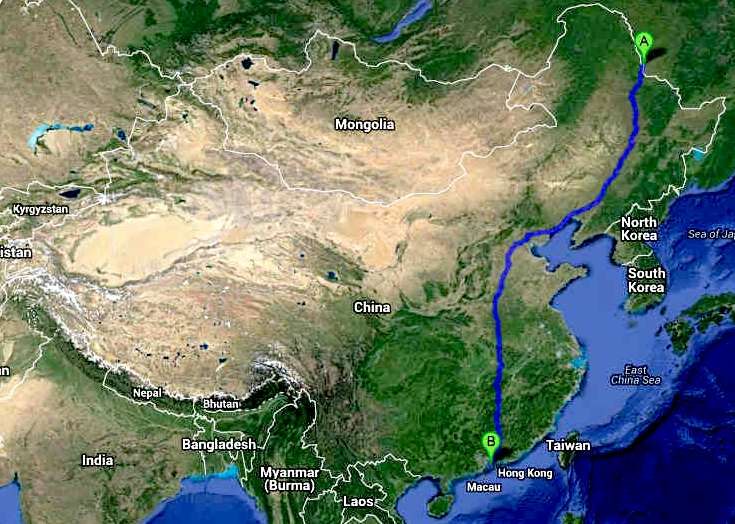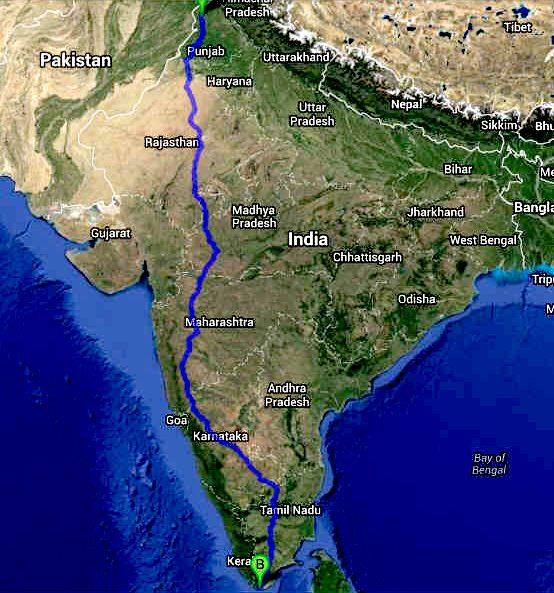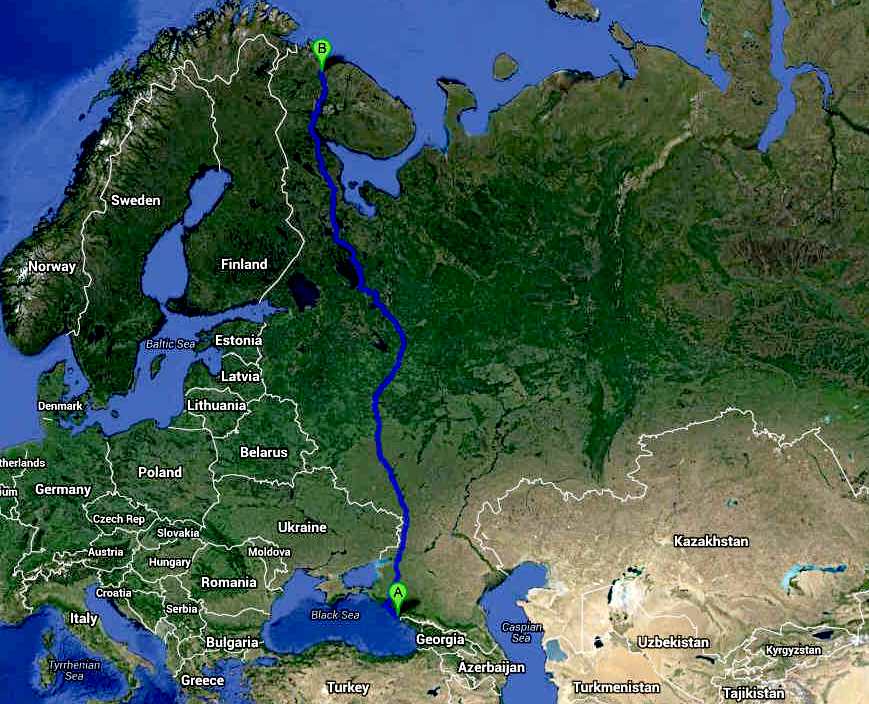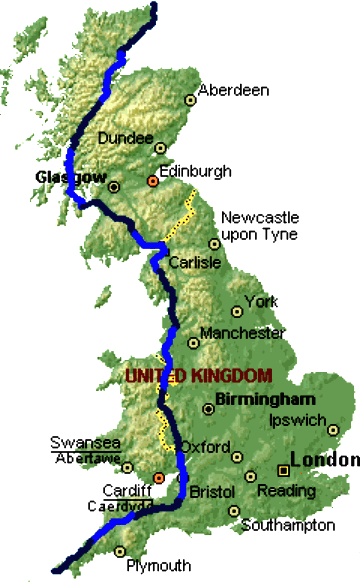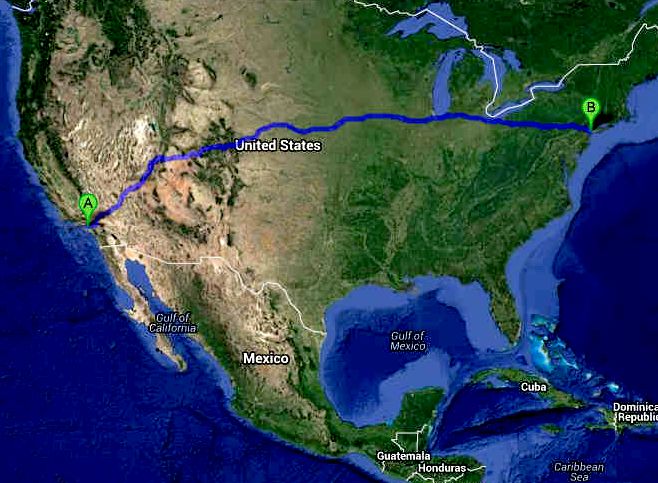|
UNITED STATES OF AMERICA
|
|||||||||||||||||||||||||||||||||||||||||||||||||||||||||||||||||||||||||||||||||||||||||||||||||||||||||||||||||||||||||
|
The United States of America is a constitutional federal republic, situated primarily in North America. It comprises 50 states and one federal district, and has several territories with differing degrees of affiliation. It is also referred to, with varying formality, as the United States, the U.S., the U.S.A., the U.S. of A., America, the States, or (poetically) Columbia.
Since the mid-20th century, following World War II, the United States has emerged as a dominant global influence in economic, political, military, scientific, technological, and cultural affairs. Because of its influence, the U.S. is considered a superpower and, particularly after the Cold War, a hyperpower by some.
George Washington 1st President of the USA
The country celebrates its founding date as July 4, 1776, when the Second Continental Congress—representing thirteen British colonies—adopted the Declaration of Independence that rejected British authority in favor of self-determination.
The structure of the government was profoundly changed in 1789, when the states replaced the Articles of Confederation with the United States Constitution. The date on which each of the fifty states adopted the Constitution is typically regarded as the date that state "entered the Union" to become part of the United States.
History
PrehistoryAmerican history began with the migration of people from Asia across the Bering land bridge some time prior to 12,000 years ago, possibly following large animals that they hunted into the Americas. These Native Americans left evidence of their presence in petroglyphs, burial mounds, and other artifacts. It is estimated that 2–9 million people lived in the territory now occupied by the U.S. before that population was diminished by European contact and the foreign diseases it brought (although both the number of Native Americans originally on the continent and the number who did not survive European immigration are the subject of continued research and thus are open to debate). Some advanced societies were the Anasazi of the southwest, who inhabited Chaco Canyon (and built sandstone buildings with up to 5 floors), and the Woodland Indians, who built Cahokia, located near present-day St. Louis, a city with a population of 41,623 at its peak in AD 1200.
European settlement
External visitors including the Norse had arrived before, but it was not until after the discovery voyages of Christopher Columbus in the late 1400s and early 1500s that European nations began to explore the land in earnest and settle there permanently.
During the 1500s and 1600s, the Spanish settled parts of the present-day Southwest and Florida. The first successful English settlement was at Jamestown, Virginia, in 1607. Within the next two decades, several Dutch settlements, including New Amsterdam (the predecessor to New York City), were established in what are now the states of New York and New Jersey. In 1637, Sweden established a colony at Fort Christina (in what is now Delaware), but lost the settlement to the Dutch in 1655.
This was followed by extensive British settlement of the east coast. The British colonists remained relatively undisturbed by their home country until after the French and Indian War when the Kingdom of Great Britain and its North American Colonies fought against France and its North American Colonies. The war resulted in France ceding Canada and the Great Lakes region to Britain, and Spain gaining Louisiana in compensation for its loss of Florida to Britain.
Later that year, the British government under George III issued the Royal Proclamation of 1763 that placed a boundary upon the westward expansion of the British North American colonies. The Proclamation's goal was to force colonists to negotiate with the Native Americans for the lawful purchase of the land and, therefore, to reduce the costly frontier warfare that had erupted over land conflicts.
To pay for the North American war a tax was imposed, as it was becoming increasingly difficult for the crown to pay for its military excursions and the defence of the American colonies from native uprisings. The colonists widely resented the taxes as they were denied representation in the British Parliament. Tensions between Britain and the colonists increased, and the thirteen colonies eventually rebelled against British rule.
The Statue of Liberty was a centennial gift to the United States from France
Nationhood
In 1776, the 13 colonies declared independence from Great Britain and formed the United States, the world's first constitutional and democratic federal republic. The American Revolutionary War followed (1775 to 1783).
The original political structure was a confederation in 1777, ratified in 1781 as the Articles of Confederation. After long debate, this was supplanted in 1789 by the Constitution, which formed a more centralized federal government.
Civil War
From early colonial times, there was a shortage of labor, which encouraged unfree labor, particularly indentured servitude and slavery. By the mid-19th century, a major division over the issue of states' rights and the expansion of slavery came to a head.
The northern states had become opposed to slavery, while the southern states saw it as necessary for the continued success of southern agriculture and wanted it expanded to newer territories in the West. Several federal laws were passed in an attempt to settle the dispute, including the Missouri Compromise and the Compromise of 1850.
The dispute reached a crisis in 1861, when seven southern states seceded from the Union and formed the Confederate States of America, leading to the Civil War. Soon after the war began, four more southern states seceded, and two states had both Union and Confederate governments.
During the war, President Abraham Lincoln issued the Emancipation Proclamation, mandating the freedom of all slaves in states in rebellion. However, full emancipation did not take place until after the end of the war in 1865, the dissolution of the Confederacy, and the Thirteenth Amendment took effect. The Civil War effectively ended the question of a state's right to secede, and is widely accepted as a major turning point after which the federal government became more powerful than state governments.
American westward expansion is idealized in Emanuel Leutze's famous painting Westward the Course of Empire Takes its Way (1861)
Expansion
During the 19th century, many new states were added to the union as the nation expanded across the continent. Manifest Destiny was a philosophy that encouraged westward expansion in the United States: as the population of the Eastern states grew and as a steady increase of immigrants entered the country, settlers moved steadily westward across North America.
In the process, the U.S. displaced most American Indian nations. This displacement of American Indians continues to be a matter of contention in the U.S., with many tribes attempting to assert their original claims to various lands. In some areas, American Indian populations had been reduced by foreign diseases contracted through contact with European settlers, and US settlers acquired those emptied lands. In other instances, American Indians were removed from their traditional lands by force. Though some would say the U.S. was not a colonial power until it acquired territories in the Spanish-American War, the dominion exercised over land in North America the United States claimed is essentially colonial.
During this period, the nation also became an industrial power and a center for innovation and technological development
Map depicting territorial acquisitions and dates of statehood The 20th century
The 20th century has sometimes been termed "the American Century" because of the nation's influence on the world. Its relative influence was especially great because Europe, which had been the center of greatest influence, was devastated during the world wars.
The U.S. fought in World War I and World War II on the side of the Allies. Between the wars, the most significant event was the Great Depression (1929 to 1939), which was compounded by drought and dust. Like the rest of the developed world, the U.S. was pulled out of the great depression by its mobilization for World War II. The war left much of the developed world in ruins with the Americas largely spared. By 1950, more than half of the global economy (as measured in GNP) was located in the U.S.
During the Cold War, the U.S. was a major player in the Korean War and Vietnam War, and, along with the Soviet Union, was considered one of the world's two "superpowers". This period coincided with a major economic expansion. With the collapse of the Soviet Union in the early 1990s, however, the U.S. emerged as the world's leading economic and military power.
During the first decade of the twenty-first century, the United States has been involved in other military conflicts, notably the Iraq War and Operation Enduring Freedom-Afghanistan.
Geography and climate
Geography
The United States shares land borders with Canada (to the north) and Mexico (to the south), and territorial water boundaries with Canada, Russia, the Bahamas, and numerous smaller nations. It is otherwise bounded by the Pacific Ocean and the Bering Sea, in the west; the Arctic Ocean, in the northernmost areas; and the Atlantic Ocean, the Gulf of Mexico, and the Caribbean Sea, in the eastern and southeastern areas.
Forty-eight of the states are in the single region between Canada and Mexico; this group is referred to, with varying precision and formality, as the continental or contiguous United States, sometimes abbreviated CONUS, and as the Lower 48. Alaska, which is not included in the term contiguous United States, is at the northwestern end of North America, separated from the Lower 48 by Canada. The state of Hawaii is an archipelago in the Pacific Ocean. The capital city, Washington, District of Columbia is a federal district located on land donated by the state of Maryland. (Virginia also donated land, but it was returned in 1847.) The United States also has overseas territories with varying levels of independence and organization.
In total area (which includes inland water and land), only Russia and Canada are larger than the United States; if inland water is excluded, China ranks second, the U.S. ranks third, and Canada ranks fourth. The United States' total area is 3,718,711 square miles (9,631,418 km²), of which land makes up 3,537,438 square miles (9,161,923 km²) and water makes up 181,273 square miles (469,495 km²).
The United States' landscape is one of the most varied among those of the world's nations: among its many features are temperate forestland and rolling hills, on the east coast; mangrove, in Florida; the Great Plains, in the center of the country; the Mississippi–Missouri river system; the Great Lakes, four of the five of which are shared with Canada; the Rocky Mountains, west of the Great Plains; deserts and temperate coastal zones, west of the Rocky Mountains; and temperate rain forests, in the Pacific northwest. Alaska's tundra, and the volcanic, tropical islands of Hawaii add to the geographic diversity.
Dramatic landscape of the American West: Grand Canyon river Colorado
Climate
The climate varies along with the landscape, from tropical in Hawaii and southern Florida to tundra in Alaska and atop some of the highest mountains. Most of the North and East experience a temperate continental climate, with warm summers and cold winters. Most of the South experiences a subtropical humid climate with mild winters and long, hot, humid summers. Rainfall decreases markedly from the humid forests of the Eastern Great Plains to the semi-arid shortgrass prairies on the high plains abutting the Rocky Mountains. Arid deserts, including the Mojave, extend through the lowlands and valleys of the southwest, from westernmost Texas to California and northward throughout much of Nevada. Some parts of California have a Mediterranean climate. Rainforests line the windward mountains of the Pacific Northwest from Oregon to Alaska.
The Constitution is the supreme law of the United States.
GovernmentRepublic and suffrage
The United States is an example of a constitutional republic, with a government composed of and operating through a set of limited powers imposed by its design and enumerated in the United States Constitution. The government has changed significantly over time, beginning as a republic in which voting was commonly restricted to white men who owned land, and direct elections were held only for the House of Representatives. Today, the United States is much more democratic, in that Senators are now directly elected by the citizens of their respective states. Originally, Senators and members of the electoral college were to be selected in a manner selected by the individual states. Under this original system, most Senators and electors were chosen by a majority vote of their state's legislature. Specifically, the nation operates as a presidential democracy.
There are three levels of government: federal, state, and local. Officials of each of these levels are either elected by eligible voters via secret ballot or appointed by other elected officials. Almost all electoral offices are decided in "first-past-the-post" elections, where a specific candidate who earns at least a plurality of the vote is elected to office, rather than a party being elected to a seat to which it may appoint an official. Americans enjoy almost universal suffrage from the age of 18 regardless of race, sex, or wealth. There are some limits, however: felons are disenfranchised and in some states former felons are likewise. Furthermore, the national representation of territories and the federal district of Washington, DC in Congress is limited: residents of the District of Columbia are subject to federal laws and federal taxes but their only Congressional representative is a non-voting delegate.
Federal government
The federal government is comprised of the Legislative Branch (led by Congress), the Executive Branch (led by the President), and the Judicial Branch (led by the Supreme Court). These three branches were designed to apply checks and balances on each other. The Constitution limits the powers of the federal government to defense, foreign affairs, the issuing and management of currency, the management of trade and relations between the states, and the protection of human rights. In addition to these explicitly stated powers, the federal government—with the assistance of the Supreme Court—has gradually extended these powers into such areas as welfare and education, on the basis of the "necessary and proper" and "Commerce" clauses of the Constitution.
Legislative branch
The Congress of the United States is the legislative branch of the federal government of the United States. It is bicameral, being comprised of the House of Representatives and the Senate. The House of Representatives consists of 435 members, each of whom represents a congressional district and serves for a two-year term. House seats are apportioned among the states by population; in contrast, each state has two Senators, regardless of population. There are a total of 100 senators, who serve six-year terms. The powers of Congress are limited to those enumerated in the Constitution; all other powers are reserved to the states and the people. The Constitution also includes the necessary-and-proper clause, which grants Congress the power to "make all laws which shall be necessary and proper for carrying into execution the foregoing powers."
Executive branch
All executive power in the federal government is vested in the President of the United States, although power is often delegated to his/her Cabinet members and advice sought from a staff. The President and Vice President are elected as 'running mates' for four-year terms by the Electoral College, for which each state, as well as the District of Columbia, is allocated a number of seats based on its representation (or ostensible representation, in the case of D.C.) in both houses of Congress.
The President makes around 2,000 executive appointments, including members of the Cabinet and ambassadors, which must be approved by the Senate; the President can also issue executive orders and pardons, and has other Constitutional duties, among them the requirement to give a State of the Union address to Congress once a year. (The Constitution does not specify that the state of the union address be delivered in person; it can be in the form of a letter, as was the practice during most of the 19th century.) Although the President's constitutional role may appear to be constrained, in practice, the office carries enormous prestige that typically eclipses the power of Congress: the Presidency has justifiably been referred to as 'the most powerful office in the world'. The Vice President is first in the line of succession, and is the President of the Senate ex officio, with the ability to cast a tie-breaking vote. The members of the President's Cabinet are responsible for administering the various departments of state, including the Department of Defense, the Justice Department, and the State Department. These departments and department heads have considerable regulatory and political power, and it is they who are responsible for executing federal laws and regulations. George W. Bush is the 43rd President, currently serving his second term.
Judicial branch
The highest court is the Supreme Court, which currently consists of nine justices. The court deals with federal and constitutional matters, and can declare legislation or executive action made at any level of the government as unconstitutional, nullifying the law and creating precedent for future law and decisions. Below the Supreme Court are the courts of appeals, and below them in turn are the district courts, which are the general trial courts for federal law. Separate from, but not entirely independent of, this federal court system are the individual court systems of each state, each dealing with its own laws and having its own judicial rules and procedures. A case may be appealed from a state court to a federal court only if there is a federal question (an issue arising under the US Constitution, or laws/treaties of the United States); the supreme court of each state is the final authority on the interpretation of that state's laws and constitution.
Map of USA with state names
State, tribal, and local governments
The state governments have the greatest influence over people's daily lives. Each state has its own written constitution and has different laws. There are sometimes great differences in law and procedure between the different states, concerning issues such as property, crime, health, and education. The highest elected official of each state is the Governor. Each state also has an elected legislature (bicameral in every state except Nebraska), whose members represent the different parts of the state. Of note is the New Hampshire legislature, which is the third-largest legislative body in the English-speaking world, and has one representative for every 3,000 people. Each state maintains its own judiciary, with the lowest level typically being county courts, and culminating in each state supreme court, though sometimes named differently. In some states, supreme and lower court justices are elected by the people; in others, they are appointed, as they are in the federal system. See state court for more information.
As a result of the Supreme Court case Worcester v. Georgia, Indian tribes are considered "domestic dependent nations" that operate as sovereign governments subject to Federal authority but, generally, outside of the influence from state governments. Hundreds of laws, executive orders, and court cases have modified the governmental status of tribes vis-à-vis states, but have kept the two officially distinct. Tribal capacity to operate robust governments varies, from a simple council used to manage all aspects of tribal affairs, to large and complex bureaucracies with several branches of government. Tribes are empowered to form their own governments, with power resting in elected tribal councils, elected tribal chairpersons, or religiously appointed leaders (as is the case with pueblos). Tribal citizenship (and voting rights) is generally restricted to individuals of Native descent, but tribes are free to set whatever membership requirements they wish.
The institutions that are responsible for local government are typically town, city, or county boards, making laws that affect their particular area. These laws concern issues such as traffic, the sale of alcohol, and keeping animals. The highest elected official of a town or city is usually the mayor. In New England, towns operate in a direct democratic fashion, and in some states, such as Rhode Island and Connecticut, counties have little or no power, existing only as geographic distinctions. In other areas, county governments have more power, such as to collect taxes and maintain law enforcement agencies.
Fort Knox - Federal gold reserves
GOLD RESERVES
Fort Knox, Maine's largest historic fort, features stunning military architecture and master granite craftsmanship. Constructed between 1844 and 1864 by master craftsmen and never fully completed, this is an unaltered example of a large mid-19th century granite coastal fortification. It is also New England's finest unmodified specimen of military architecture of the period.
The main fort building measures 252 by 146 feet. The fort's two levels contain mounts for 64 cannons. Four batteries, with a total of 69 cannons, cover lines of defense. Visitors are welcome to explore the fort's passageways and many rooms. The fort also features two complete Rodman cannons. Guided tours are available daily during the summer season.
Political divisions
With the Declaration of Independence, the thirteen colonies proclaimed themselves to be polities modeled after the European states of the time. Although considered as sovereigns initially, under the Articles of Confederation of 1781 they entered into a "Perpetual Union" and created a fully sovereign federal state, delegating certain powers to the national Congress, including the right to engage in diplomatic relations and to levy war, while each retaining their individual sovereignty, freedom and independence. But the national government proved too ineffective, so the administrative structure of the government was vastly reorganized with the United States Constitution of 1789. Under this new union, the continued status of the individual states as sovereign nation states fell into dispute in 1861, as several states attempted to secede from the union; in response, then-President Abraham Lincoln claimed that such secession was illegal, and the result was the American Civil War.
Since the Union victory in 1865, the independent status of the individual states has not been broached again by any state, and the status of each state within the union has been deemed by mainstream officials and academics to be settled as being subordinate to the union as a whole.
In subsequent years, the number of states grew steadily due to western expansion, the purchase of lands by the national government from other nation states, and the subdivision of existing states, resulting in the current total of 50. The states are generally divided into smaller administrative regions, including counties, cities and townships.
The United States–Canadian border is the longest undefended political boundary in the world. The U.S. is divided into three distinct sections:
The United States also holds several other territories, districts, and possessions, notably the federal district of the District of Columbia, which is the nation's capital, and several overseas insular areas, the most significant of which are American Samoa, Guam, the Northern Mariana Islands, Puerto Rico, and the United States Virgin Islands. The Palmyra Atoll is the United States' only incorporated territory; it is unorganized and uninhabited.
Islands gained by the United States in the war against Spain at the turn of the 20th century were no longer to be considered foreign territory; on the other hand, the United States Supreme Court declared that they were not automatically covered by the Constitution and that it was up to Congress to decide what portions of the Constitution, if any, applied to them. This had been the precisely the quarrel between American colonies and Great Britain that resulted in the founding of the United States. Seen like this, the Supreme Court in 1901 would have decided in favor of George III of the United Kingdom.
The United States Navy has held a base at a portion of Guantanamo Bay, Cuba, since 1898. The United States government possesses a lease to this land, which only mutual agreement or United States abandonment of the area can terminate. The present Cuban government of Fidel Castro disputes this arrangement, claiming Cuba was not truly sovereign at the time of the signing. The United States argues this point moot because Cuba apparently ratified the lease post-revolution, and with full sovereignty, when it cashed one rent check in accordance with the disputed treaty.
The Pentagon
Foreign relations and military
The immense military and economic strength of the United States has made its foreign relations an especially important topic in international politics. Reactions towards United States foreign policy by other nationalities are often strong, ranging from admiration to fierce criticism. The same range of opinions is also found within the United States, with many Americans either supporting or strongly criticizing United States foreign policy.
The First nation to receive foreign aid from the United States was Venezuela. In 1812, Venezuela, fighting for its indepence from Spain, suffered a severe and damaging earthquake. Congress appropriated $50,000 to help the victims. Morocco was the first contry to recognize the United States of America (1777).
Traditionally, the greatest military ally of the United States is the United Kingdom, though the earliest alliance the nation formed was with France (see Franco-American relations).
The military force of the United States has been decisive in several major foreign wars, most notably World War II and, to a lesser degree, World War I.
The United States presently occupies 702 military bases worldwide in 132 different countries. The United States is currently involved in a War in Iraq, a War in Afghanistan, and an intervention in Haiti. They have also embarked upon a War on Terrorism.
The United States currently enjoys a positive relationship with the United Kingdom, Australia, Japan, and Poland, among several others, in that these nations are participating as active military allies with, or logistical supporters of, the United States in all theaters. Canada, Germany, and some others, are participating in the Afghanistan theater but not in Iraq.
Three of the nation's four military branches are administered by the Department of Defense: the Army, the Navy (including the Marine Corps), and the Air Force. The Coast Guard falls under the jurisdiction of the Department of Homeland Security in peacetime, but is placed under the Department of Defense in time of war.
The combined United States armed forces consist of 1.4 million active duty personnel, along with several hundred thousand each in the Reserves and the National Guard. Military conscription ended in 1973. The United States armed forces are considered to be the most powerful military (of any sort) in the world, and their force projection capabilities are unrivalled. It is considered dominant on water, land, air, and space.
The 2005 defense budget amounted to $401.7 billion, which is an increase of 4% over 2004 and of 35% since 2001. Over 50% of that number is spent in research & development. U.S. defense expenditure is estimated to be greater than the next twelve largest national military budgets combined.
It should be noted that the United States' focus on military expenditures has ranged very broadly, due to the regularly changing ideology inherent in its political system. The American military, in terms of physical resources, is actually smaller now than it was twenty years ago, despite being larger than it was five years ago, for example.
Human rights debates
The United States is often under criticism from Western governments and NGOs concerning lengthy detention without trial, forced confessions, torture, and mistreatment of prisoners as well as some restrictions on freedoms of speech and the press, as being violations of their definition of human rights.
Economy
The United States has the largest single-country economy in the world, with a per-capita annual gross domestic product of $41,747 (as of Q2 2005 [2]). In this market-oriented economy, private individuals and business firms make most of the decisions, and the federal and state governments buy needed goods and services predominantly in the private marketplace. This is financed via taxes and borrowings in the money and capital markets. Federal borrowings are subject to borrowing caps to theoretically prevent fiscal irresponsibilty. The cap as of 2004 stands at 8.2 trillion. (Borrowings as of November 2005 are 8.1 trillion.)
U.S. dollar is the national currency.
The largest industry in the U.S. is now service, which employs roughly three quarters of the work force. The United States has many natural resources, including oil and gas, metals, and such minerals as gold, soda ash, and zinc. In agriculture, it is a top producer of, among other crops, corn, soy beans, rice and wheat; the United States is a net exporter of food. The manufacturing sector produces goods such as cars, airplanes, steel, and electronics, among many others.
Economic activity varies greatly from one part of the country to another, with many industries being concentrated in certain cities or regions. For example, New York City is the center of the American financial, publishing, broadcasting, and advertising industries. Silicon Valley is the country's largest high technology hub, while Los Angeles is the most important center for film production. The Midwest is known for its reliance on manufacturing and heavy industry, with Detroit, Michigan, serving as the center of the American automotive industry. The Great Plains are known as the "breadbasket" of America for their tremendous agricultural output; the intermountain region serves as a mining hub and natural gas resource; the Pacific Northwest for fish and timber, while Texas is largely associated with the oil industry; and the Southeast is a major hub for both medical research and the textiles industry.
Several countries continue to link their currency to the dollar or even use it as a currency (such as Ecuador), although this practice has subsided since the collapse of the Bretton Woods system. Many markets are also quoted in dollars, such as those of oil and gold. The dollar is also the predominant reserve currency in the world, and more than half of global reserves are in dollars.
The largest trading partner of the United States is Canada (19%), followed by China (12%), Mexico (11%), and Japan (8%). More than 50% of total trade is with these four countries.
In 2003, the United States was ranked as the third most visited tourist destination in the world; its 40,400,000 visitors ranked behind France's 75,000,000 and Spain's 52,500,000.
Labor unions have existed since the 19th century, and grew large and powerful from the 1930s to the 1950s. See Labor history of the United States. Since 1970 they have shrunk in the private sector and now cover fewer than 8% of the workers. However union membership has grown rapidly in the public sector, especially among teachers, nurses, police, postal workers, and municipal clerks. There have been few strikes in recent years.
THE WHITE HOUSE
For two hundred years, the White House has stood as a symbol of the Presidency, the United States government, and the American people. Its history, and the history of the nation’s capital, began when President George Washington signed an Act of Congress in December of 1790 declaring that the federal government would reside in a district "not exceeding ten miles square…on the river Potomac."
President Washington, together with city planner Pierre L’Enfant, chose the site for the new residence, which is now 1600 Pennsylvania Avenue. As preparations began for the new federal city, a competition was held to find a builder of the "President’s House." Nine proposals were submitted, and Irish-born architect James Hoban won a gold medal for his practical and handsome design.
Construction began when the first cornerstone was laid in October of 1792. Although President Washington oversaw the construction of the house, he never lived in it. It was not until 1800, when the White House was nearly completed, that its first residents, President John Adams and his wife, Abigail, moved in.
The White House - Presidential Residence
White House Links:
The United States' imports exceed exports by 80%, leading to an annual trade deficit of $700,000 million or 6% of gross domestic product. It is the largest debtor nation in the world, with total gross foreign liabilities of over $12,000,000 million as of 2004; and it absorbs more than 50% of global savings annually.
Since the 1980s, the U.S. has increased the use of neoliberal economic policies that reduce government intervention and reduce the size of the welfare state, backing away from the more interventionist Keynesian economic policies that had been in favor since the Great Depression. As a result, the United States provides fewer government-delivered social welfare services than most industrialized nations, choosing instead to keep its tax burden lower and relying more heavily on the free market and private charities.
Sixteen states and the District of Columbia have minimum wages higher than the national level ($5.15 per-hour), including the highest, Washington State at $7.35. Twenty-six states are the same as the federal level; two — Ohio and Kansas — are below; and six do not have state laws.
The United Nations Development Programme Report 2005 ranks income the United States as the 74th most equal out of 124 countries, as measured by the Gini coefficient. The richest 10% make 15.9 times as much as the poorest 10%, and the richest 20% make 8.4 times as much as the poorest 20%.
America's poverty line, defined for a family of four as an income of less than $19,157, is at 12.7% of the general population. Approximately one out of every five children in the United States grows up below the official poverty line. Among racial groups; American Indians and Alaska Natives have the lowest median income while Asians have the highest. Regionally, the southern states have the lowest median incomes while the West Coast and New England have the highest. The former Federal Reserve Chairman Alan Greenspan remarked that the U.S.’s growing income inequality since the 1970s is, "not the type of thing which a democratic society - a capitalist democratic society - can really accept without addressing."[3] However, Greenspan also noted, "...you can look at the system and say it's got a lot of problems to it, and sure it does. It always has. But you can't get around the fact that this is the most extraordinarily successful economy in history."
The Pentagon - directly overhead
Demographics
Population
The mean center of the U.S. population continues to drift farther west and south. The fastest growing region is the West, followed by the South. Growth in some parts of the nation have been particularly extreme such as the fastest growing metropolitan area, Las Vegas, Nevada, which went from 273,288 people in 1970 to about 1,650,671 in 2004. Between 1990 and 2000, 19 of the 20 fastest-growing states were in these two regions.[4]
Major demographic trends include the mass immigration of Hispanics from Latin America into the Southwest, which is home to 60 percent (21 of the 35 million) of the nation's Hispanics (their numbers increased 57.9% nationally in the 1990s). The West Coast has been the residence of choice for immigrating Asians, particularly from China. The West Coast is now home to approximately half of all American citizens of Asian ancestry (5 of the 10 million; increasing 52.4% in number during the 1990s).
Ethnicity and race
The United States is a very racially diverse country. According to the 2000 census, it has 31 ethnic groups with at least one million members each, and numerous others represented in smaller amounts.
The majority of Americans descend from white European immigrants who arrived after the establishment of the first colonies (most after Reconstruction). This majority--69% in 2000--decreases each year, and is expected to become a plurality within a few decades. The most frequently stated European ancestries are German (15.2%), Irish (10.8%), English (8.7%), Italian (5.6%) and Scandinavian (3.7%). Many immigrants also hail from Slavic countries such as Poland and Russia. Other significant immigrant populations came from eastern and southern Europe and French Canada.
Hispanics from Mexico and South and Central America are second only to the German-American population. Hispanics comprise 13% of the population (2000 census). People of Mexican descent made up 7.3% of the population in the 2000 census, and this proportion is expected to increase significantly in the coming decades.
Approximately 12.9% (2000 census) of the American people designated themselves as Black alone or in combination with some other race (African American). African Americans are spread throughout the country, but their proportional population is largest in the South.
Asian Americans, including Native Hawaiians and Pacific Islanders, are a third significant minority (4% of the population in 2000). Most Asian Americans are concentrated on the West Coast and Hawaii. The largest groups are immigrants or descendants of emigrants from the Philippines, China, India, Vietnam, South Korea, and Japan.
Indigenous peoples in the United States, such as American Indians and Inuit, make up 1% of the population (2000 census). About 35% live on Indian reservations.
For the first time ever, American citizens were able to list all of the racial, ethnic, or ancestry groups which they felt was appropriate for them. For example, a dual ancestry person was counted in the Italian and the Irish ancestry group or a biracial person was counted in the White and Black groups.
Religion
There is no official Religion in the United States, but polls estimate that 80 percent of Americans are Christians of various denominations. While Christianity is growing in America, it is not growing as fast as the general population resulting in a 10 per cent decline from 90 percent as recently as 1990. About 2 percent of Americans follow Judaism. The other 18 percent is comprised of people of no religion and other religions, such as Hinduism, Islam, and Buddhism.
The United States is noteworthy among developed nations for its relatively high level of religiosity. According to a 2004 Gallup poll, about 44% of Americans attend a religious service at least once a week. However, this rate is not uniform across the country; attendance is more common in the Bible Belt—composed largely of Southern and Midwestern states—than in the Northeast and West Coast. In the Southern states, Baptists are the largest group, followed by Methodists; Roman Catholics are dominant in the Northeast and in large parts of the Midwest due to their being settled by descendants of Catholic immigrants from Europe (such as Germany, Ireland, Italy, and Poland) or other parts of North America (mainly Quebec and Puerto Rico). The rest of the country for the most part has a complex mixture of various Christian groups.
According to census figures and related polls, neo-paganism is the fastest growing organized religion in the United States though its numbers of adherents are rated below 800,000 in the United States as of 2000. This reflects a growing diversification of religious belief in the United States over the last few decades.
Public health
The United States has several public health problems: widespread obesity, unhealthy diets, progressing HIV-AIDS epidemic and cigarette smoking among over quarter of the population.
Unlike in most western countries, the government does not provide universal health insurance for all citizens. Even so, government spending on health care is the highest of any country in the world with major programs such as Medicare and Medicaid. Health insurance in the United States is traditionally a benefit of employment, and many cases this is mandated by law. It should also be noted that providing emergency care if needed is required by law of any licensed emergency care facility regardless of the patient's ability to pay. Medical bills are the most common reason for personal bankruptcy in the United States, and it is estimated that roughly 45 Million Americans have no health coverage.
Elvis Presley had a world impact on music and youth culture
People and culture
U.S. popular culture has a significant influence on the rest of the world, especially the Western world. U.S. music is heard all over the world, and it is the sire of such forms as blues and jazz and had a primary hand in the shaping of modern rock and roll and popular music culture. Many famous Western classical musicians and ensembles find their home in the U.S. New York City is a hub for international operatic and instrumental music as well as the world-famed Broadway plays and musicals. Nashville is the center of the country music industry. Another export of the last 20 years is hip hop music, which began in New York and is growing in influence as it branches into the fashion, food and drink, and movie industries. New York, Seattle, and San Francisco are worldwide leaders in graphic design and New York and Los Angeles compete with major European cities in the fashion industry.
U.S. movies (primarily embodied in Hollywood) and television shows can be seen almost anywhere except the most totalitarian places. This is in stark contrast to the early days of the republic, when the country was viewed by Europeans as an agricultural backwater with little to offer the culturally advanced world centers of Asia and Europe.
Nearing the mid-point of its third century of nationhood, the U.S. plays host to the gamut of human intellectual and artistic endeavor in nearly every major city, offering classical and popular music; historical, scientific and art research centers and museums; dance performances, musicals and plays; outdoor art projects and internationally significant architecture. This development is a result of both contributions by private philanthropists and government funding.
American holidays are variously national and local. Many holidays recognize events or people of importance to the nation's history; as such, they represent significant cultural observance.
Language
The United States does not have an official language at the federal level. English is the language generally used for official pronouncements, though there is legislation that assists non-English speakers, such as the Voting Rights Language Assistance Act of 1992, which prohibits covered States and political subdivisions from providing English-only voting materials.
Twenty-seven individual states have adopted English as their official language, and three of those—Hawaii, Louisiana, and New Mexico—have also adopted a second official language (Hawaiian, French and Spanish, respectively). Spanish and German follows English as the second-most spoken languages primarily due to the influence of Latin American, German, Austrian and Swiss immigrants. German is the primary spoken language in some areas of the Amish. Spanish is the first language of Puerto Rico.
The primary signed language is American Sign Language (ASL). As of 2004, the United States was the home of approximately 336 languages (spoken or signed), of which 176 are indigenous to U.S. territory.
Cultural icons: Apple pie, baseball, and the American flag
Largest cities
The United States has dozens of major cities, including 11 of the 55 global cities of all types — with three "alpha" global cities: New York City, Los Angeles, and Chicago. The figures expressed below are for populations within city limits. A different ranking is evident when considering U.S. metro area populations, although the top three would be unchanged. Note that some cities not listed (such as Atlanta, Boston, Las Vegas, Miami, New Orleans, Seattle, San Francisco and Washington, D.C.) are still considered important on the basis of other factors and issues, including culture, economics, heritage, and politics. The ten largest cities, based on the United States Census Bureau's 2004 estimates, are as follows:
Education
In the United States, education is a state, not federal, responsibility, and the laws and standards vary considerably. However, the federal government, through the Department of Education, is involved with funding of some programs and exerts some influence through its ability to control funding. In most states, all students must attend mandatory schooling starting with kindergarten, which children normally enter at age 5, and following through 12th grade, which is normally completed at age 18 (although in some states, students are permitted to drop out upon the age of 16 with the permission of their parents/guardians). Parents may educate their own children at home (with varying degrees of state oversight), send their children to a public school, which is funded with tax money, or to a private school, where parents must pay tuition. Public schools are highly decentralized with funding and curriculum decisions taking place mostly at the local level through school boards.
After high school, students may choose to continue their schooling at a public/state university or a private university. Public universities receive funding from the federal and state government but students still pay tuition, which can vary depending on the university, state, and whether the student is a resident of the state or not. Tuition at private universities tends to be much higher than at public universities. It is not uncommon for students to join the workforce or the military before attending college; both the military and many private employers may subsidize post-secondary education.
It should be noted that the United States is one of the few industrialized countries to not provide a free university education to its citizenry. It does however, provide financial aid in the form of grants and loans to eligible students for university education. But by doing so it, unlike other nations, leaves some of its young citizenry in substantial debt, although many upper and middle-class students' parents foot the bill, while lower-class students generally receive mostly grants.
Stack interchange in Los Angeles
Transportation
Because the automobile industry took off very early in United States (when compared to other Western nations) much of the development of U.S. urban areas has taken place around the concept of creating cities and residential areas to suit the needs of road vehicles. The automobile industry was quick to attain influence in government and media alike, and was also the force behind the dismantling of the electric rail transport systems or trolleys in over 40 U.S. cities through a subsidiary called National City Lines. To link its vast territory, the United States built a network of high-capacity, high-speed highways, of which the most important element is the Interstate Highway system. These highways were commissioned in the 1950s by President Dwight D. Eisenhower and modeled after the German Autobahn. There is also a transcontinental rail system, which is used for moving freight across the lower forty-eight states. Passenger rail service is provided by Amtrak, which serves forty-six of the lower forty-eight states.
Many cities still have extensive mass-transit systems. The largest of them, New York City operates one of the world's most heavily used subway systems. The regional rail and bus networks that extend into Long Island, New Jersey, Upstate New York, and Connecticut are among the most heavily used in the world.
Air
travel is the preferred means of travel
for long distances. In terms of passengers, seventeen of the world's
thirty busiest airports in 2004 were in the U.S., including the world's
busiest, Hartsfield-Jackson Atlanta International Airport. In terms of
cargo, in the same year, twelve of the world's thirty busiest airports
were in the U.S., including the world's busiest, Memphis International
Airport. There are several major seaports in the United States; the three
busiest are the Port of Los Angeles, California; the Port of Long Beach,
California; and the Port of New York and New Jersey. Others include
Duluth, Minnesota, Houston, Texas; Charleston, South Carolina; Savannah,
Georgia; Miami, Florida; Portland, Oregon; San Francisco, California;
Boston, Massachusetts; Philadelphia, Pennsylvania; and Seattle,
Washington; plus, outside the contiguous forty-eight states, Anchorage,
Alaska, and Honolulu, Hawaii.
American football is a popular spectator sport in the US
Sports
The major team sports in America are home-grown. American football, baseball (often called "The National Pastime"), auto racing (especially NASCAR), and basketball, are the top four main sports in America. Ice hockey is also popular in the U.S., especially in the Upper Midwest and Northeast. Although it is currently one of the most played sports amongst American youth, soccer does not have a particularly large following in the U.S. in contrast to its extreme popularity in most other countries. Nevertheless, the U.S. did host the World Cup in 1994. Professional sports in America is very big business and its athletes are very well compensated. The majority of the world's highest paid athletes play team sports in America [5].
The United States also hosts large followings of traditional European sporting events. Horse racing is popular as a gambling event and the United States hosts several world renowned horse racing events, including the Kentucky Derby. Rugby Union has also established itself as a popular sport with a loyal following. Other European sports such as polo and cricket, while not popular, do attract players and have established leagues.
The United States hosts some of the premier events in other sports such as golf (including three of the four majors), and tennis (the U.S. Open). The most popular form of auto racing is NASCAR. Formula One, while dominant in the rest of the world, has only made limited inroads into the U.S. market. The only Formula One event currently in the U.S. is the United States Grand Prix. However, the visually similar Indy 500 is the nation's most famous racing event, and both the U.S. Grand Prix and the Indy 500 currently take place at the Indianapolis Motor Speedway.
EXTEL Cup drivers practice for the 2004 Daytona 500
In the 20th century, the United States became the center of the two most popular Western combat sports—boxing, which is popular as both a spectator sport and a gambling event, and professional wrestling, which is more scripted entertainment than a true sport. The United States has produced many champion boxers who have become public figures in their own right. Other combat sports based on Asian martial arts, such as karate competitions, maintain large national leagues and hold frequent competitions.
The number of gun owners in America has given widespread popularity to shooting sports as an amateur pastime. Competitions on marksmanship and other firearm related skills are a regular feature at many shooting ranges. Several organizations (such as the National Rifle Association) maintain national leagues or participate in international leagues such as the ISSF. The United States also developed a unique shooting sport in the 1980s called cowboy action shooting.
The three popular board-based recreational sports - surfboarding, skateboarding and snowboarding were created in The United States. While first practiced by native Hawaiians, Americans were almost solely responsible for creating surfboarding's worldwide popularity. Skateboarding and snowboarding are completely modern American inventions, and all three have given rise to national competitions and a large dedicated subculture. Snowboarding is the only one of the three to become an Olympic event, beginning with the Winter Olympics in 1998.
Eight Olympic Games have been hosted in the U.S., more than in any other nation. The United States generally fares fairly well in the Olympics especially the Summer Olympics: in 2004, the U.S. topped the medals table with a record 103 medals (35 gold, 39 silver and 29 bronze). For details see United States at the Olympics.
During times of extreme popularity certain teams have been (unofficially) crowned "America's team." The New York Yankees, the Chicago Bulls and New York Knicks, and the Dallas Cowboys and New York Giants, are examples of teams that have reached this status.
American college sports are nearly as popular as professional sports, particularly college football and college basketball. American colleges often support wide-ranging sports programs, including track and field and more eclectic sports such as water polo.
LINKS:
International rankings
Globalization Index 2005, ranked 4 out of 62 countries World Competitiveness Yearbook 2005, ranked 1 out of 60 economies (countries and regions) Fourth annual worldwide press freedom index (2005), ranked 44 (American territory) & 137 (in Iraq) of 167 State of the World's Mothers 2005, ranked 11 out of 110 countries 2005 Index of Economic Freedom, ranked 12 out of 155 countries The World in 2005 - Worldwide quality-of-life index, 2005, ranked 13 out of 111 countries Corruption Perceptions Index 2005, ranked 17 out of 146 countries Global Competitiveness Report 2004-2005 - Growth Competitiveness Index Ranking, ranked 2 out of 104 Index of Environmental Sustainability Index, ranked 45 out of 146 countries.
United States government
White House - Official site of the U.S. President Senate - Official site of the United States Senate House - Official site of the United States House of Representatives Supreme Court - Official site of the Supreme Court of the United States Department of Motor Vehicles - Links to DMV/motor vehicles information for all of the United States United States - Links to official United States sites CIA World Factbook Entry for United States Official website of the United States government - Gateway to governmental sites Portrait of the USA - Published by the United States Information Agency, September 1997. The National Atlas of the United States. U.S. Census Housing and Economic Statistics Updated regularly by U.S. Bureau of the Census. U.S. Census POPClock Projection of current U.S. population WWW-VL: United States History Index
Other
National Motto: History and Constitutionality Reference: U.S. specific web resources sorted by state
Make a difference by entering one of the events that have been created for everyone to enjoy. New for 2015, the Cannonball ZEV International Run series is designed to further the development of practical and affordable zero emission transport. There are already a good number of official routes for you to contemplate with more in the pipeline from 2015.
You are cordially invited to register your interest. There is no entry fee and the events are legal, unlike the race across the US in the 1970s.
The ultimate prize is the Blue Bird World Cup Trophy™. You can see the International Rules by clicking on the poster above.
CANNONBALL ZEV INTERNATIONAL ENDURANCE EVENTS 2015 - 2018
After Tesla set two new records in 2013 and 2014, a British team has announced their plans to challenge the 24 hour and 76 records for 1. Lands End to John O'Groats and 2. Los Angeles to New York. These attempts are planned for 2015 and 2016, beginning with the Lands End cross UK ZEV Cannonball Run.
|
|||||||||||||||||||||||||||||||||||||||||||||||||||||||||||||||||||||||||||||||||||||||||||||||||||||||||||||||||||||||||
|
The
content of this website is copyright © 1991 and 2014 Max Energy Ltd -
a not for profit company. All rights reserved. The bluebird logo |
|||||||||||||||||||||||||||||||||||||||||||||||||||||||||||||||||||||||||||||||||||||||||||||||||||||||||||||||||||||||||
